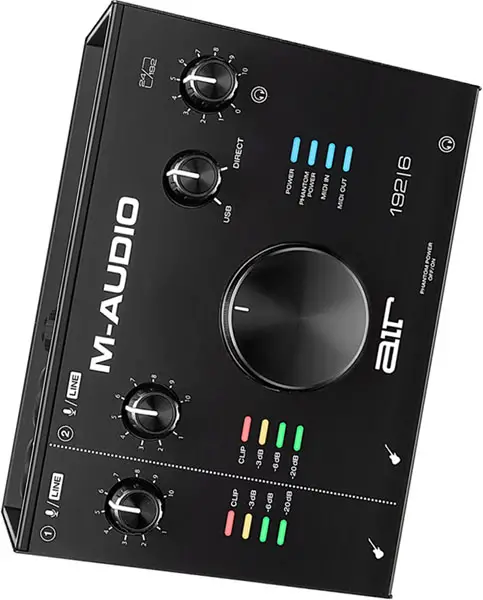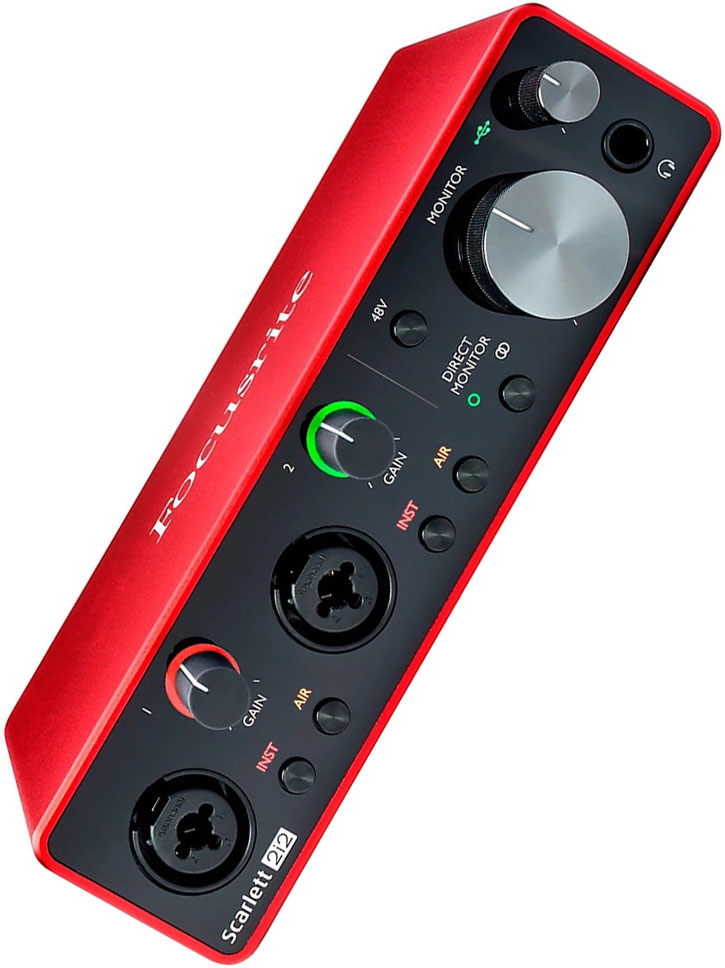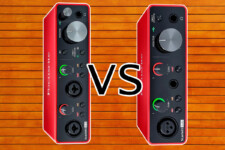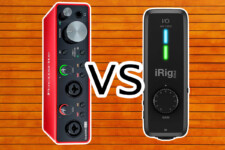M-Audio Air 192|6 vs Focusrite Scarlett 2i2 3rd Gen: Which One Is Better for Your Home Studio?
If you are looking for a reliable and affordable audio interface to record your music, podcasts, or streams, you might have come across two popular models: the M-Audio Air 192×6 and the Focusrite Scarlett 2i2 3rd Gen. Both of these devices offer high-quality sound, easy setup, and versatile features for different audio applications. But how do they compare to each other, and which one should you choose for your home studio?
The M-Audio Air 192|6 and the Focusrite Scarlett 2i2 3rd Gen are both compact and portable USB audio interfaces that provide two inputs and two outputs for recording and playback. They both have high-performance preamps, converters, and headphone amps that deliver crystal-clear sound with low latency.
However, there are also some differences between these two audio interfaces that might make one more appealing than the other depending on your preferences and goals.

A Quick Look
If you want more MIDI connectivity and a universal cable that can work with any device, you may want to choose the M-Audio Air 192|6. It has a USB Type-C cable that can connect to Lightning, USB-C, Micro-USB, or USB-A ports. It also has MIDI input and output for connecting your keyboards and controllers. It has two combo XLR-1/4″ inputs with 55 dB of gain and two 1/4″ outputs.
If you want more dynamic range and low-noise preamps, you may want to choose the Focusrite Scarlett 2i2 3rd Gen. It has two combo XLR-1/4″ inputs with up to 56 dB of gain and two 1/4″ outputs. It also has switchable phantom power, Hi-Z input, pad, and loopback functions. With a smaller footprint, this interface uses a little less desk space also.

M-Audio Air 192|6
- Mobile-ready, bus-powered, 2-in/2-out USB-C.
- Record at up to 24-bit/192kHz resolution.
- Two combo mic/line/instrument inputs with Crystal preamps and converters.
- Two balanced 1/4″ TRS main outputs and one 1/4″ headphone output with independent level controls.
- Switchable phantom power and instrument/line level for each input.
- Direct monitor knob for blending input and playback signals.

Focusrite Scarlett 2i2
- High-performance 24-bit/192kHz converters that deliver studio-quality sound.
- Two independent gain knobs with LED halo indicators that show the input level and clipping status.
- Two high-headroom instrument inputs for bass, guitar, or synths that can handle loud signals without clipping.
- Two balanced TRS outputs that can connect to studio monitors or speakers.
- USB-C connectivity that provides fast and reliable data transfer and power supply.
- A dedicated amplifier that can drive high-impedance headphones.
- Line or instrument level input selection switch.
Price Comparison
The M-Audio Air 192×6 has a list price of $199.99, while the Focusrite Scarlett 2i2 3rd Gen has a list price of $189.99. However, you might be able to find them for lower prices online or in stores depending on the availability and discounts. We’ve seen the M-Audio Air 192×6 selling for around $170, and the Focusrite Scarlett 2i2 3rd Gen for $160 USD, so shop around for the best price.
As you can see, the price difference between these two audio interfaces is not very significant, and they are both very affordable for their features and quality. However, if you are on a tight budget, you might want to go for the Focusrite Scarlett 2i2 3rd Gen, as it is slightly cheaper than the M-Audio Air 192×6.
Common Features
Let’s take a look at some of the common features that both the M-Audio Air 192×6 and the Focusrite Scarlett 2i2 3rd Gen share:
- USB-C connectivity: Both audio interfaces use USB-C connectors to connect to your computer or mobile device. This means that they are compatible with most modern computers and devices without needing adapters or extra cables.
- 24-bit/192kHz resolution: Both audio interfaces support up to 24-bit/192kHz resolution for recording and playback. This means that they can capture and reproduce every nuance and detail of your sound with high fidelity and accuracy. This is especially important if you want to record high-quality audio for professional purposes or if you want to enjoy listening to your music with headphones or speakers.
- Two combo inputs: Both audio interfaces have two combo inputs that can accept either XLR or 1/4-inch TRS connectors. This means that you can plug in either microphones or instruments (such as guitars or keyboards) into these inputs without needing extra adapters or cables. You can also switch between line-level or instrument-level signals depending on what you are plugging in.
- 48V phantom power: Both audio interfaces provide 48V phantom power for condenser microphones that require external power to operate. You can turn on or off phantom power for each input individually with a switch on the front panel of the audio interface.
- Direct monitoring: Both audio interfaces offer direct monitoring features that let you listen to your input signals without any latency or delay. Direct monitoring bypasses this process and lets you hear your input signals directly from the audio interface. This is useful if you want to record in sync with a backing track or if you want to avoid hearing any delay or echo in your headphones or speakers.
M-Audio Air 192×6 – Unique Features
- Two balanced 1/4″ TRS main outputs and one 1/4″ headphone output with independent level controls: This feature allows you to connect your audio interface to two sets of monitors or speakers and adjust the volume of each output separately. You can also connect your headphones to the dedicated headphone output and adjust the volume independently from the main outputs. This gives you more flexibility and control over your monitoring and playback options.
- Switchable phantom power and instrument/line level for each input: This feature allows you to turn on or off phantom power for each input individually with a switch on the front panel of the audio interface. You can also switch between line-level or instrument-level signals depending on what you are plugging in. This gives you more versatility and compatibility with different types of microphones and instruments.
- Direct monitor knob for blending input and playback signals: This feature allows you to adjust the balance between your input signals and your playback signals when using direct monitoring.
Focusrite Scarlett 2i2 3rd Gen – Unique Features
- Switchable Air mode that gives recordings a brighter and more open sound: This feature allows you to activate a special circuit that emulates the sound of Focusrite’s legendary ISA preamps. These preamps are known for adding a subtle boost to the high frequencies and enhancing the clarity and presence of your recordings. You can turn on or off Air mode for each input individually with a switch on the front panel of the audio interface.
- Unique and intuitive halo level indicators that show you the input level and signal clipping at a glance: This feature allows you to monitor your input level and signal clipping with LED rings around the gain knobs of each input. The LED rings change color from green to amber to red depending on the level and clipping status of your input signals. Green means that your input level is good, amber means that your input level is close to clipping, and red means that your input level is clipping.
- A direct monitor switch that lets you monitor your input with low latency in one click: This feature allows you to turn on or off direct monitoring with a single switch on the front panel of the audio interface. You can use the direct monitor switch to quickly toggle between direct monitoring and normal monitoring modes. Normal monitoring mode lets you hear your input signals after they have been processed by your computer and software. This is useful if you want to hear some effects or processing on your input signals.
Sound Quality
Another important factor that might affect your choice between these two audio interfaces is the sound quality. This is determined by several components, such as the preamps, the converters, and the headphone amps. The preamps are responsible for amplifying the input signals from your microphones or instruments to a suitable level for recording. The converters are responsible for converting the analog signals from your inputs to digital signals for your computer, and vice versa for playback. The headphone amps are responsible for driving your headphones with enough power and clarity.
The M-Audio Air 192×6 boasts its Crystal preamps and converters that deliver transparent and pristine sound with ultra-low distortion and noise. The preamps have a gain range of 55 dB, which means that they can handle a wide range of input signals without clipping or distorting. The converters have a dynamic range of 114 dB, which means that they can capture and reproduce a wide range of sound levels without losing any detail or clarity. The headphone amp has a power output of 150 mW per channel, which means that it can drive most headphones with enough volume and quality.
The Focusrite Scarlett 2i2 3rd Gen features its upgraded Scarlett preamps and converters that deliver improved sound with more headroom and less noise. The preamps have a gain range of 56 dB, which means that they can also handle a wide range of input signals without clipping or distorting. The converters have a dynamic range of 111 dB, which means that they can also capture and reproduce a wide range of sound levels without losing any detail or clarity. The headphone amp has a power output of 125 mW per channel, which means that it can also drive most headphones with enough volume and quality.
As you can see, both audio interfaces have very similar specifications when it comes to sound quality, and they both deliver excellent performance in this regard. However, if you want to be very picky, you might notice that the M-Audio Air 192×6 has slightly higher dynamic range and headphone power than the Focusrite Scarlett 2i2 3rd Gen, which might give it a slight edge in terms of sound quality.
Compatibility
Another factor that you might want to consider when choosing between these two audio interfaces is the compatibility with your computer or mobile device. This depends on the type of connection, the driver software, and the operating system that you are using.
Both audio interfaces use USB-C connectors to connect to your computer or mobile device. This means that they are compatible with most modern computers and devices without needing adapters or extra cables. However, if you have an older computer or device that does not have a USB-C port, you might need to use an adapter or a different cable to connect them.
Both audio interfaces are compatible with Windows and Mac operating systems. However, they might have different system requirements depending on the version of the operating system that you are using. For example, the M-Audio Air 192×6 requires Windows 10 (32-bit or 64-bit) or Mac OS X 10.12 or higher, while the Focusrite Scarlett 2i2 3rd Gen requires Windows 7 (64-bit) or higher or Mac OS X 10.10 or higher.
As you can see, both audio interfaces have very similar compatibility with most computers and devices, and they both use USB-C connectors. However, if you have an older computer or device that does not have a USB-C port, you might need to use an adapter or a different cable to connect them.
M-Audio Air 192×6 Pros
- Slightly higher dynamic range and headphone power than the Focusrite Scarlett 2i2 3rd Gen.
- Less expensive than Focusrite Scarlett 2i2.
- Provides MIDI I/O.
- Polished look and well-designed.
- Large central volume knob.
- Supports up to 192 kHz / 24-Bit resolution.
M-Audio Air 192×6 Cons
- Slightly more expensive than the Focusrite Scarlett 2i2 3rd Gen.
- Slightly lower dynamic range
- Slightly lower signal-to-noise ratio.
- Lower maximum input level.
- No built-in DSP or effects.
Focusrite Scarlett 2i2 3rd Gen Pros
- Slightly cheaper than the M-Audio Air 192×6.
- Slightly higher dynamic range.
- Slightly higher signal-to-noise ratio.
- Higher maximum input level.
- Supports up to 192 kHz / 24-Bit resolution1
- Includes AIR mode for emulating classic preamps.
Focusrite Scarlett 2i2 3rd Gen Cons
- Slightly lower dynamic range and headphone power than the M-Audio Air 192×6.
- No MIDI I/O (adapter or USB-C required).
- No built-in DSP or effects.
Which One Would You Choose?
If you are looking for an audio interface that has slightly higher sound quality and more virtual instruments than the Focusrite Scarlett 2i2 3rd Gen, you might want to choose the M-Audio Air 192×6. This audio interface has slightly higher dynamic range and headphone power than the Focusrite Scarlett 2i2 3rd Gen, which might give it a slight edge in terms of sound quality.
It also comes with more virtual instruments than the Focusrite Scarlett 2i2 3rd Gen, such as Xpand!2, Mini Grand, Vacuum, BOOM, and DB-33. These virtual instruments can help you create and produce various genres and styles of music without needing extra hardware or software.
If you are looking for an audio interface that is slightly cheaper and has more effects plugins than the M-Audio Air 192×6, you might want to choose the Focusrite Scarlett 2i2 3rd Gen. It also comes with more effects plugins than the M-Audio Air 192|6, such as Softube Time and Tone Bundle, Focusrite Red Plug-in Suite, and XLN Audio Addictive Keys.
Both audio interfaces are excellent options for your home studio, and they both offer high-quality sound, easy setup, and versatile features for different audio applications. You can’t go wrong with either one of them.




